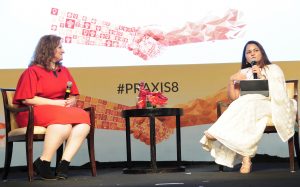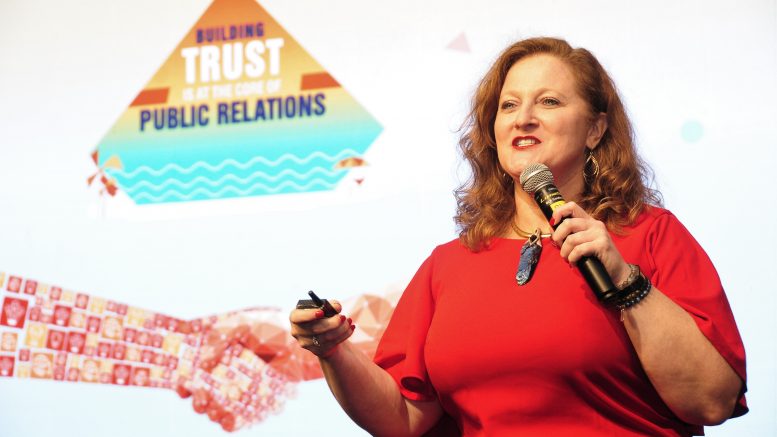To be effective, ‘trust’ must be cultivated. And earning trust is a long, drawn-out process. Many brands today, try to measure customer trust by checking out customer loyalty, which is a clear indication whether customers trust the brand and the business.
Can trust be measured? This was the topic of the keynote address given by Johna Burke, Global Managing Director, AMEC at #PRAXIS8. “For those who are concerned, this session is going to help you build trust with your clients and with the C-suite”, she said as she opened her keynote address.
Establishing the authenticity of “measurement” per se, she pointed out that it is a powerful tool and when you use it correctly, and it will make you the most trusted advocate and the “go-to person” whenever there is a crisis or if you are looking to excel in something.
If you are talking to your C-suite of clicks and likes, you are doing wrong; if you are talking to your customers about impressions, you are doing wrong. Her take was that this is indeed, a “dangerous environment” and hence she specified tools that will help in creating conversations with clients with the basic motive of helping them. That’s where trust enters.
Connecting to popular folklore, she threw open a question to the audience. “How many of you would love it, if there were silver bullets?” How many times do we desperately hope that something that acts as a magical weapon to suddenly show up, especially one that instantly solves a long-standing problem? But, there is no universal silver bullet and that is a good thing, she said. “A silver bullet only works on werewolves,” she exclaimed. There are a host of questions that waylay us on the path of measurement. Questions that she was often asked were – what is that one metric that you need to use or what is that one problem that you are trying to solve for clients?
The solution is not a magical ‘silver bullet’, but setting an objective or setting a purpose is the most important beginning. We are familiar with SMART objectives, but here, we came face-to-face with SMARTE (Specific, Measurable, Attainable, Realistic, Timebound) where the extra ‘E’ stood for ‘Ethical’. Are your objectives ethical, she questioned. Are we revolutionising or doing something that really matters? Are you doing something that really matters to the business or your organisation? Very often, people get it wrong so that they set objectives that are “dumb”, which will not impact the business. If you are only looking at the impact that it can have on the business, it minimises the effect and the impact communication can have. “Be brave, be bold”, she advised and to put those objectives out there and make sure you have a foundation.
At AMEC, they work with volunteers and there are no tricks or delusions involved. They will tell clients where you are in the process like – “here’s where you are, and here’s where you need to go!” One of the most sought-after skills for hiring for clients and individuals is – “cognitive thinking”; people want people who are able to think, who are able to give a perspective – for that is something that will help them.
One of the basic tools she mentioned was – Barcelona Principles (updated in 2015), which is a fabulous foundation of what you are trying to do. If you have a project and don’t have a goal, then there isn’t anything measurable! “Setting goals and objectives are fundamental for PR and communication,” she insisted.
Another point she raised was that “one of the reasons, why some people miss out is because they measure outputs, not outcomes!” They check if press releases have been released, coverage has been got, social media coverage (especially now with earned media and fake news)…but, is that driving the business? “One key factor is how the information you are measuring is sourced,” she said and then went on to add, on a satirical note, that “Trump taught us many valuable lessons in communication!”
The AMEC framework, we got to know is another research online and it will tell you what your inputs are and it is “a great way to get the common language with your team”. At the planning stage, it will make you more effective and trustworthy when it gets to demonstrate the outcome for a business organisation. And how does one do that? One way is to study how the organisation makes and spends money – which is a great way to determine where they spend time and resources and how to drive and impact their values. Another way is – how the organisation’s performance can be measured, where it’s possible. “This is where some external features of trust come into play”, she said. The overall success is in understanding where these lie in the ecosystem.
Illustrating the different aspects of businesses through communication she referred to IRIC – which spelt out Increase-Reduce-Improve-Create. Measurement, she said means quantitative and qualitative methods, and her word of advice was – “make sure you understand the merits”.
Referring to AI, she pointed out that “facial recognition is a great example of machine learning, and we can teach the machine to work but it is not perfect”. Ultimately, it is important that we need to look at and identify what are those elements that matter to our business and to our clients. “Don’t fear failure, but know why you fail!” she cautioned.

Johna Burke in conversation with Deepshikha Dharmaraj, Genesis BCW
In a conversation with Deepshikha Dharmaraj, Managing Director, Genesis BCW when she mentioned the need for qualitative and quantitative data, Johna was quick to answer that “qualitative data is the easiest”. About setting a goal for a communication problem, how can you set the right objectives? Johna suggested that “one of the first things to look at is – what really does success mean to you? That is what will give you measurable objectives. “Measurement has to be the DNA of every program you do,” she concluded.






Be the first to comment on "Can trust be measured?"